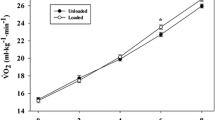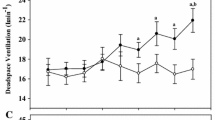Abstract
The aim is to quantify the physiological cost of head-load carriage and to examine the ‘free ride’ hypothesis for head-load carriage in groups of women differing in their experience of head-loading. Twenty-four Xhosa women [13 experienced head-loaders (EXP), 11 with no experience of head-loading (NON)] attempted to carry loads of up to 70% of body mass on both their heads and backs whilst walking on a treadmill at a self-selected walking speed. Expired air was collected throughout. In a second study nine women, members of the British Territorial Army, carried similar loads, again at a self-selected speed. Maximum load carried was greater for the back than the head (54.7 ± 15.1 vs. 40.8 ± 13.2% BM, P < 0.0005). Considering study one, head-loading required a greater oxygen rate than back-loading (10.1 ± 2.6 vs. 8.8 ± 2.3 ml kg bodymass−1 min−1, P = 0.043, for loads 10–25% BM) regardless of previous head-loading experience (P = 0.333). Percentage changes in oxygen consumption associated with head-loading were greater than the proportional load added in both studies but were smaller than the added load for the lighter loads carried on the back in study 1. All other physiological variables were consistent with changes in oxygen consumption. The data provides no support for the ‘free ride’ hypothesis for head-loading although there is some evidence of energy saving mechanisms for back-loading at low speed/load combinations. Investigating the large individual variation in response may help in identifying combinations of factors that contribute to improved economy.




Similar content being viewed by others
References
Abe D, Yanagawa K, Niihata S (2004) Effect of load carriage, load position, and walking speed on energy cost of walking. Appl Ergon 35:329–335
Abe D, Muraki S, Yasukouchi A (2008) Ergonomic effects of load carriage on energy cost of gradient walking. Appl Ergon 35:329–335
Al-Khabbaz YS, Shimada T, Hasegawa M (2008) The effect of backpack heaviness on trunk–lower extremity muscle activities and trunk posture. Gait Posture 28(2):297–302
Bastien GJ, Willems PA, Schepens B, Heglund NC (2005a) Effect of load and speed on the energetic cost of human walking. Eur J Appl Physiol 94:76–83
Bastien GJ, Schepens P, Willems PA, Heglund NC (2005b) Energetics of load carrying in Nepalese porters. Science 308:1755
Birrell SA, Hooper RH (2007) Initial subjective load carriage injury data collected with interviews and questionnaires. Mil Med 172(3):306–311
Birrell SA, Hooper RH, Haslam RA (2007) The effect of military load carriage on ground reaction forces. Gait Posture 26:611–614
Bobet J, Norman RW (1984) Effects of load placement on back muscle activity in load carriage. Eur J Appl Physiol 53(1):71–75
Cavagna GA, Willems PA, Legramandi MA, Heglund NC (2002) Pendular energy transduction within the step in human walking. J Exp Biol 205:3413–3422
Charteris J, Nottrodt JW, Scott PA (1989a) The ‘free ride’ hypothesis: a second look at the efficiency of African women headload carriers. S Afr J Sci 85:68–71
Charteris J, Scott PA, Nottrodt JW (1989b) Metabolic and kinematic responses of African women headload carriers under controlled conditions of load and speed. Ergonomics 32:1539–1550
Chow HK, Kwok M, Au-Yanf A, Holmes A, Cheng J, Yao F, Wong MS (2005) The effect of backpack load on the gait of normal adolescent girls. Ergonomics 6:642–656
Datta SR, Ramanathan NL (1971) Ergonomic comparison of seven modes of carrying loads on the horizontal plane. Ergonomics 14(2):269–278
Datta SR, Chatterjee BB, Roy BN (1973) The relationship between energy expenditure and pulse rates with body weight and the load carried during load carrying on the level. Ergonomics 16(4):507–513
Heglund NC, Willems PA, Penta M, Cavagna GA (1995) Energy saving gait mechanics with head-supported loads. Nature 375:52–54
Holewijn M (1990) Physiological strain due to load carrying. Eur J Appl Physiol 61(3–4):237–245
Jones CDR, Jarjou MS, Whitbread RG, Jequier E (1987) Fatness and the energy cost of carrying loads in African women. Lancet 12:1331–1332
Kirk J, Schneider DA (1992) Physiological and perceptual responses to load-carrying in female subjects using internal and external frame backpacks. Ergonomics 35(4):445–455
LaFiandra M, Wagenaar RC, Holt KG, Obusek JP (2003) How do load carriage and walking speed influence trunk coordination and stride parameters? J Biomech 36:87–95
Legg SJ, Mahanty A (1985) Comparison of five modes of carrying a load close to the trunk. Ergonomics 28:1653–1660
Li JX, Hong Y, Robinson PD (2003) The effect of load carriage on movement kinematics and respiratory parameters in children during walking. Eur J Appl Physiol 90:35–43
Lloyd R, Cooke CB (2000a) The oxygen consumption associated with unloaded walking and load carriage using two different backpack designs. Eur J Appl Physiol 81(6):486–492
Lloyd R, Cooke CB (2000b) Relationships between physiological and postural adjustments to load carriage for rucksack designs. J Sports Sci 18:25–26
Lyons J, Allsopp A, Bilzon J (2005) Influences of body composition upon the relative metabolic and cardiovascular demands of load carriage. Occup Med 55:380–384
Mackie HW, Legg SJ (2008) Postural and subjective responses to realistic schoolbag carriage. Ergonomics 51(2):217–231
Maloiy GM, Heglund NC, Prager LM, Cavagna GA, Taylor CR (1986) Energetic costs of carrying loads: have African women discovered an economic way? Nature 319:668–669
Malville NJ, Burns WC, Lim HA, Basnyat R (2001) Commercial porters of Eastern Nepal: health status, physical work capacity and energy expenditure. Am J Hum Biol 13:44–56
Minetti AE, Formenti F, Ardigo LP (2006) Himalayan porter’s specialization: metabolic power, economy, efficiency and skill. Proc R Soc B 273:2791–2797
Nag PK, Sen RN, Ray US (1979) Cardio-respiratory performance of porters carrying loads on a treadmill. Ergonomics 22(8):897–907
Obusek JP, Harman EA, Frykman PN, Palmer CJ, Bills RK (1997) The relationship of backpack center of mass location to the metabolic cost of load carriage. Med Sci Sports Exerc 29(5):S205
Quesada PM, Mengelkoch LJ, Hale RC, Simon SR (2000) Biomechanical and metabolic effects of varying backpack loading on simulated marching. Ergonomics 43(3):293–309
Rorke SL (1990) Selected factors influencing the “optimum” backpack load for hiking. S Afr J Res Sport Phys Educ Recreat 13:31–45
Sharpe SR, Holt KG, Saltzman E, Wagenaar RC (2008) Effects of hip belt on transverse plane trunk coordination and stability during load carriage. J Biomech 41:968–976
Soule RG, Goldman RF (1969) Energy costs of loads carried on the head, hands or feet. J Appl Physiol 27:687–690
Stuempfle KJ, Drury DG, Wilson AL (2004) Effect of load position on physiological and perceptual responses during load carriage with an internal frame backpack. Ergonomics 47(7):784–789
Taylor CR, Heglund NC, McMahon TA, Looney TR (1980) Energetic cost of generating muscular force during running. J Exp Biol 86:9–18
Acknowledgments
This work was funded by: The Carnegie Trust for Higher Education in Scotland; The School of Social and Health Sciences, University of Abertay Dundee; The Department of Sport Management, Cape Peninsula University of Technology.
Author information
Authors and Affiliations
Corresponding author
Additional information
Communicated by Jaap van Dieen.
Rights and permissions
About this article
Cite this article
Lloyd, R., Parr, B., Davies, S. et al. A comparison of the physiological consequences of head-loading and back-loading for African and European women. Eur J Appl Physiol 109, 607–616 (2010). https://doi.org/10.1007/s00421-010-1395-9
Accepted:
Published:
Issue Date:
DOI: https://doi.org/10.1007/s00421-010-1395-9




